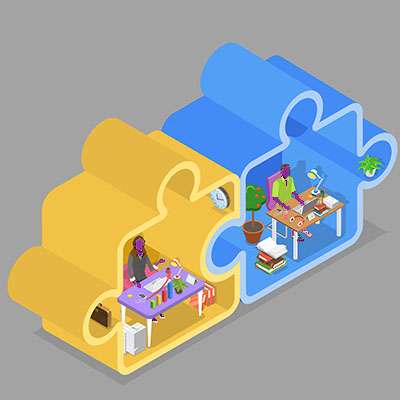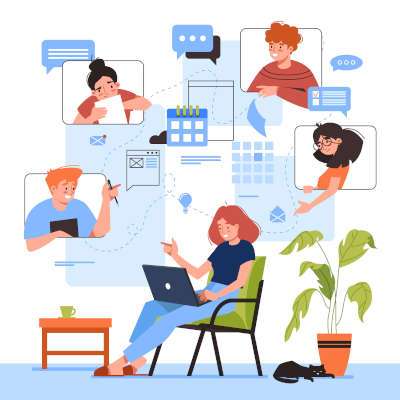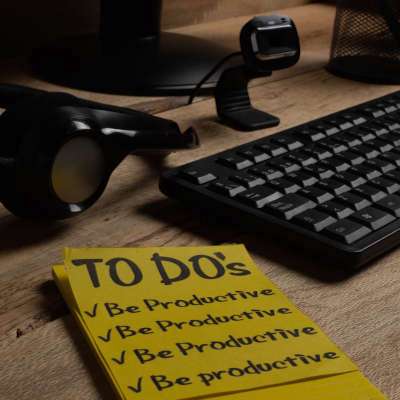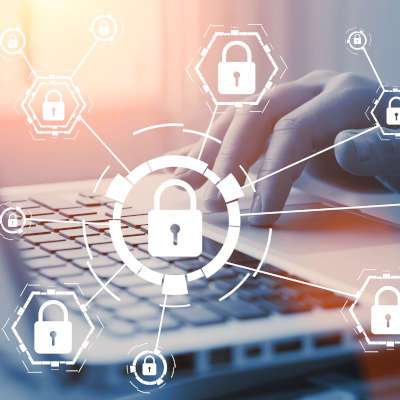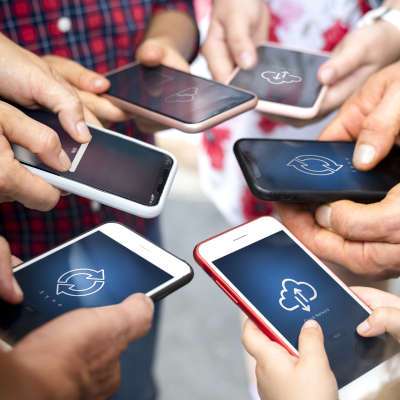Have you ever gotten a message that just makes your heart sink in your chest? Chances are good that your team members feel that way whenever you send them a particular message, especially during certain times. Below we consider why this may be the case, and how you can better manage your communications to more effectively communicate with your team.
Macro Systems Blog
Many businesses, seeking to balance the positives brought by remote work to the value that in-person, face-to-face operations provide, have leaned into hybrid work practices. This has led to many reconsidering how their office space is set up. How are these considerations shaping the modern workplace?
With remote work becoming the standard for many businesses in their efforts to maintain operations in recent months, this potentially company-saving adoption has not been without its disadvantages. Most notably, the mental health of many employees has been impacted as teams have been working together while keeping apart, in large part because the quick conversations that happen throughout the workday have mostly been eliminated.
Due to the Covid-19 Pandemic, many businesses are maintaining their operations by enabling remote work. While we normally focus on how you should properly take care of your technology, we wanted to shift our focus momentarily to the people using this technology, and how they can do so more safely.
To do so, we have to consider ergonomics.
At any given time, a business needs to consider its security, but this need only intensifies when its employees are working remotely. With the coronavirus pandemic very much still in play, the likelihood that your workers are in this situation has risen dramatically. In order to maintain your organizational security, you must consider the many factors that a remote workforce can introduce.
There are many reasons that your employees may need to work from home, and there are many reasons to allow them to do so. A 2019 survey by OwlLabs indicated that 71 % of remote workers are happy with their job compared to 55 percent of on-site workers; remote workers responded that they are 13 % more likely than onsite workers to stay in their current job for five more years than onsite workers will; and when respondents claimed to be working longer than 40 hours per week, onsite workers were doing so out of necessity, while remote workers did so out of desire and enjoyment.
As the coronavirus outbreak continues creating global health concerns, Macro Systems wants to address how it could affect businesses that lack the preparations required to account for such an event. More specifically, we wanted to discuss why events like these add even more reasons that a file share and sync solution is a critical addition to your IT resources.
 Apple is at it again. After record breaking sales of the new iPhone 5s, Apple announced a new product line with confidence. CEO Tim Cooke and his staff recently launched new MacBook models, the Mac Pro workstation, a new OS, a new iPad mini model, and the most anticipated highlight: the new iPad Air.
Apple is at it again. After record breaking sales of the new iPhone 5s, Apple announced a new product line with confidence. CEO Tim Cooke and his staff recently launched new MacBook models, the Mac Pro workstation, a new OS, a new iPad mini model, and the most anticipated highlight: the new iPad Air.
 In the world of business technology, industries are looking to save money as often as possible while maintaining or improving the productivity of their employees. One such method is with a BYOD strategy, or Bring Your Own Device. Some businesses allow their team to bring in and use their own devices for work purposes, but whether or not this actually saves them money is another story altogether.
In the world of business technology, industries are looking to save money as often as possible while maintaining or improving the productivity of their employees. One such method is with a BYOD strategy, or Bring Your Own Device. Some businesses allow their team to bring in and use their own devices for work purposes, but whether or not this actually saves them money is another story altogether.
 Doing business in today's world is dependant on mobility, and if you aren't ready to shift toward this new technology trend, you should seriously reconsider. A lot of the time, businesses will allow their employees to bring in their own mobile devices for use in the workplace. This trend is called a Bring Your Own Device (BYOD).
Doing business in today's world is dependant on mobility, and if you aren't ready to shift toward this new technology trend, you should seriously reconsider. A lot of the time, businesses will allow their employees to bring in their own mobile devices for use in the workplace. This trend is called a Bring Your Own Device (BYOD).
 As a responsible business owner, you know that using the latest technology and running updated software is a key component to your company's network security. However, your employees may not value the latest tech like you do, which could result in a major data breach, despite your best efforts to keep your company current.
As a responsible business owner, you know that using the latest technology and running updated software is a key component to your company's network security. However, your employees may not value the latest tech like you do, which could result in a major data breach, despite your best efforts to keep your company current.
 The modern office has been heavily influenced by technology. Today, offices revolve around computers, but even before computers became commonplace, offices were still designed around the technology of their time. As we're witnessing technology change the world, the modern office is sure to follow suit.
The modern office has been heavily influenced by technology. Today, offices revolve around computers, but even before computers became commonplace, offices were still designed around the technology of their time. As we're witnessing technology change the world, the modern office is sure to follow suit.
 Microsoft is well known for their software, but manufacturing tablet computers is a new venture for the tech giant. It's been almost a year since Microsoft's signature tablet the Surface Pro was released, and now the second generation of Surface, the Surface Pro 2, is available. Here's an overview on how the new tablet stacks up.
Microsoft is well known for their software, but manufacturing tablet computers is a new venture for the tech giant. It's been almost a year since Microsoft's signature tablet the Surface Pro was released, and now the second generation of Surface, the Surface Pro 2, is available. Here's an overview on how the new tablet stacks up.
 In our last blog article, we introduced the IT trend of employees bringing in their personal devices to work (BYOD). We looked at 5 ways BYOD can help your business, but BYOD is not without risks. In part 2, we will cover five risks BYOD brings to your company's network and what you can to do manage them.
In our last blog article, we introduced the IT trend of employees bringing in their personal devices to work (BYOD). We looked at 5 ways BYOD can help your business, but BYOD is not without risks. In part 2, we will cover five risks BYOD brings to your company's network and what you can to do manage them.
 The latest trend in business technology is employees bringing in their personal devices to work. This trend is commonly referred to as BYOD (Bring Your Own Device), and it's presenting businesses with both new opportunities and challenges. We will breakdown BYOD into 2 parts: benefits and risks. In part 1, we will look at five benefits of BYOD.
The latest trend in business technology is employees bringing in their personal devices to work. This trend is commonly referred to as BYOD (Bring Your Own Device), and it's presenting businesses with both new opportunities and challenges. We will breakdown BYOD into 2 parts: benefits and risks. In part 1, we will look at five benefits of BYOD.
 If you're in retail, then you know the satisfaction of the loud "ka-ching" sound your cash register makes at the end of a transaction. It's a great sound, which is why you mimic it after draining a three-pointer in basketball. Although, with the way technology is trending, the famous "ka-ching" noise may soon be forgotten.
If you're in retail, then you know the satisfaction of the loud "ka-ching" sound your cash register makes at the end of a transaction. It's a great sound, which is why you mimic it after draining a three-pointer in basketball. Although, with the way technology is trending, the famous "ka-ching" noise may soon be forgotten.


